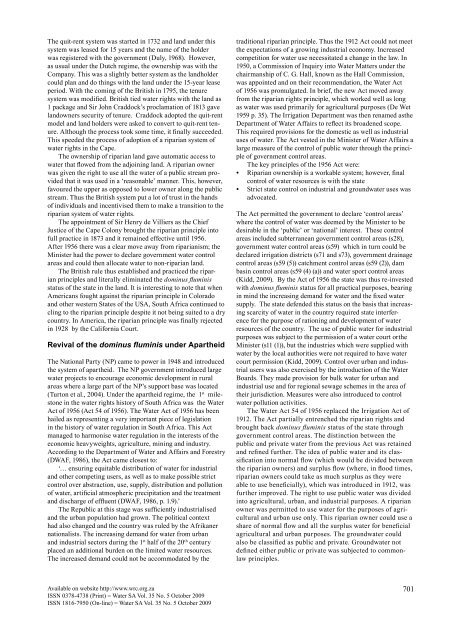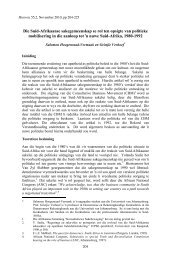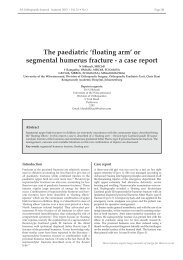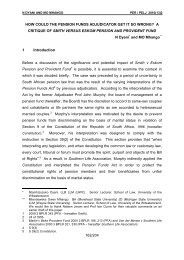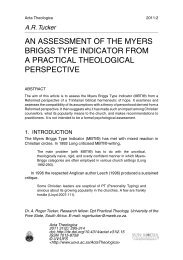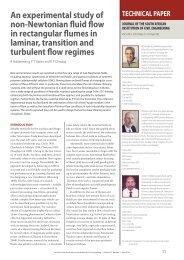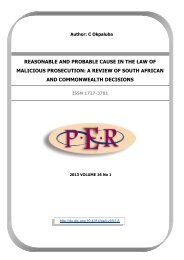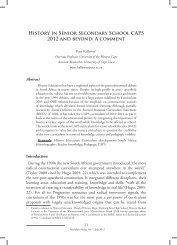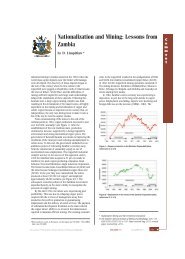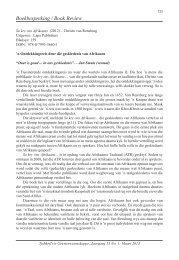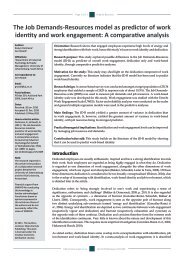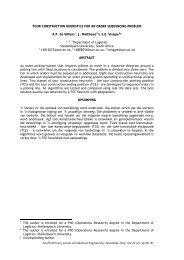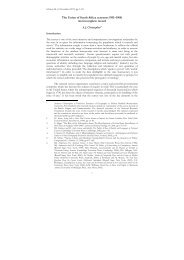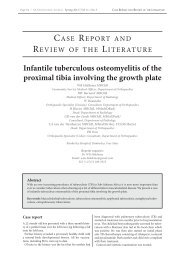A detailed analysis of evolution of water rights in South Africa: An ...
A detailed analysis of evolution of water rights in South Africa: An ...
A detailed analysis of evolution of water rights in South Africa: An ...
You also want an ePaper? Increase the reach of your titles
YUMPU automatically turns print PDFs into web optimized ePapers that Google loves.
The quit-rent system was started <strong>in</strong> 1732 and land under this<br />
system was leased for 15 years and the name <strong>of</strong> the holder<br />
was registered with the government (Duly, 1968). However,<br />
as usual under the Dutch regime, the ownership was with the<br />
Company. This was a slightly better system as the landholder<br />
could plan and do th<strong>in</strong>gs with the land under the 15-year lease<br />
period. With the com<strong>in</strong>g <strong>of</strong> the British <strong>in</strong> 1795, the tenure<br />
system was modified. British tied <strong>water</strong> <strong>rights</strong> with the land as<br />
1 package and Sir John Craddock’s proclamation <strong>of</strong> 1813 gave<br />
landowners security <strong>of</strong> tenure. Craddock adopted the quit-rent<br />
model and land holders were asked to convert to quit-rent tenure.<br />
Although the process took some time, it f<strong>in</strong>ally succeeded.<br />
This speeded the process <strong>of</strong> adoption <strong>of</strong> a riparian system <strong>of</strong><br />
<strong>water</strong> <strong>rights</strong> <strong>in</strong> the Cape.<br />
The ownership <strong>of</strong> riparian land gave automatic access to<br />
<strong>water</strong> that flowed from the adjo<strong>in</strong><strong>in</strong>g land. A riparian owner<br />
was given the right to use all the <strong>water</strong> <strong>of</strong> a public stream provided<br />
that it was used <strong>in</strong> a ‘reasonable’ manner. This, however,<br />
favoured the upper as opposed to lower owner along the public<br />
stream. Thus the British system put a lot <strong>of</strong> trust <strong>in</strong> the hands<br />
<strong>of</strong> <strong>in</strong>dividuals and <strong>in</strong>centivised them to make a transition to the<br />
riparian system <strong>of</strong> <strong>water</strong> <strong>rights</strong>.<br />
The appo<strong>in</strong>tment <strong>of</strong> Sir Henry de Villiers as the Chief<br />
Justice <strong>of</strong> the Cape Colony brought the riparian pr<strong>in</strong>ciple <strong>in</strong>to<br />
full practice <strong>in</strong> 1873 and it rema<strong>in</strong>ed effective until 1956.<br />
After 1956 there was a clear move away from riparianism; the<br />
M<strong>in</strong>ister had the power to declare government <strong>water</strong> control<br />
areas and could then allocate <strong>water</strong> to non-riparian land.<br />
The British rule thus established and practiced the riparian<br />
pr<strong>in</strong>ciples and literally elim<strong>in</strong>ated the dom<strong>in</strong>us flum<strong>in</strong>is<br />
status <strong>of</strong> the state <strong>in</strong> the land. It is <strong>in</strong>terest<strong>in</strong>g to note that when<br />
Americans fought aga<strong>in</strong>st the riparian pr<strong>in</strong>ciple <strong>in</strong> Colorado<br />
and other western States <strong>of</strong> the USA, <strong>South</strong> <strong>Africa</strong> cont<strong>in</strong>ued to<br />
cl<strong>in</strong>g to the riparian pr<strong>in</strong>ciple despite it not be<strong>in</strong>g suited to a dry<br />
country. In America, the riparian pr<strong>in</strong>ciple was f<strong>in</strong>ally rejected<br />
<strong>in</strong> 1928 by the California Court.<br />
Revival <strong>of</strong> the dom<strong>in</strong>us flum<strong>in</strong>is under Apartheid<br />
The National Party (NP) came to power <strong>in</strong> 1948 and <strong>in</strong>troduced<br />
the system <strong>of</strong> apartheid. The NP government <strong>in</strong>troduced large<br />
<strong>water</strong> projects to encourage economic development <strong>in</strong> rural<br />
areas where a large part <strong>of</strong> the NP’s support base was located<br />
(Turton et al., 2004). Under the apartheid regime, the 1 st milestone<br />
<strong>in</strong> the <strong>water</strong> <strong>rights</strong> history <strong>of</strong> <strong>South</strong> <strong>Africa</strong> was the Water<br />
Act <strong>of</strong> 1956 (Act 54 <strong>of</strong> 1956). The Water Act <strong>of</strong> 1956 has been<br />
hailed as represent<strong>in</strong>g a very important piece <strong>of</strong> legislation<br />
<strong>in</strong> the history <strong>of</strong> <strong>water</strong> regulation <strong>in</strong> <strong>South</strong> <strong>Africa</strong>. This Act<br />
managed to harmonise <strong>water</strong> regulation <strong>in</strong> the <strong>in</strong>terests <strong>of</strong> the<br />
economic heavyweights, agriculture, m<strong>in</strong><strong>in</strong>g and <strong>in</strong>dustry.<br />
Accord<strong>in</strong>g to the Department <strong>of</strong> Water and Affairs and Forestry<br />
(DWAF, 1986), the Act came closest to:<br />
‘… ensur<strong>in</strong>g equitable distribution <strong>of</strong> <strong>water</strong> for <strong>in</strong>dustrial<br />
and other compet<strong>in</strong>g users, as well as to make possible strict<br />
control over abstraction, use, supply, distribution and pollution<br />
<strong>of</strong> <strong>water</strong>, artificial atmospheric precipitation and the treatment<br />
and discharge <strong>of</strong> effluent (DWAF, 1986, p. 1.9).’<br />
The Republic at this stage was sufficiently <strong>in</strong>dustrialised<br />
and the urban population had grown. The political context<br />
had also changed and the country was ruled by the Afrikaner<br />
nationalists. The <strong>in</strong>creas<strong>in</strong>g demand for <strong>water</strong> from urban<br />
and <strong>in</strong>dustrial sectors dur<strong>in</strong>g the 1 st half <strong>of</strong> the 20 th century<br />
placed an additional burden on the limited <strong>water</strong> resources.<br />
The <strong>in</strong>creased demand could not be accommodated by the<br />
traditional riparian pr<strong>in</strong>ciple. Thus the 1912 Act could not meet<br />
the expectations <strong>of</strong> a grow<strong>in</strong>g <strong>in</strong>dustrial economy. Increased<br />
competition for <strong>water</strong> use necessitated a change <strong>in</strong> the law. In<br />
1950, a Commission <strong>of</strong> Inquiry <strong>in</strong>to Water Matters under the<br />
chairmanship <strong>of</strong> C. G. Hall, known as the Hall Commission,<br />
was appo<strong>in</strong>ted and on their recommendation, the Water Act<br />
<strong>of</strong> 1956 was promulgated. In brief, the new Act moved away<br />
from the riparian <strong>rights</strong> pr<strong>in</strong>ciple, which worked well as long<br />
as <strong>water</strong> was used primarily for agricultural purposes (De Wet<br />
1959 p. 35). The Irrigation Department was then renamed asthe<br />
Department <strong>of</strong> Water Affairs to reflect its broadened scope.<br />
This required provisions for the domestic as well as <strong>in</strong>dustrial<br />
uses <strong>of</strong> <strong>water</strong>. The Act vested <strong>in</strong> the M<strong>in</strong>ister <strong>of</strong> Water Affairs a<br />
large measure <strong>of</strong> the control <strong>of</strong> public <strong>water</strong> through the pr<strong>in</strong>ciple<br />
<strong>of</strong> government control areas.<br />
The key pr<strong>in</strong>ciples <strong>of</strong> the 1956 Act were:<br />
• Riparian ownership is a workable system; however, f<strong>in</strong>al<br />
control <strong>of</strong> <strong>water</strong> resources is with the state<br />
• Strict state control on <strong>in</strong>dustrial and ground<strong>water</strong> uses was<br />
advocated.<br />
The Act permitted the government to declare ‘control areas’<br />
where the control <strong>of</strong> <strong>water</strong> was deemed by the M<strong>in</strong>ister to be<br />
desirable <strong>in</strong> the ‘public’ or ‘national’ <strong>in</strong>terest. These control<br />
areas <strong>in</strong>cluded subterranean government control areas (s28),<br />
government <strong>water</strong> control areas (s59) which <strong>in</strong> turn could be<br />
declared irrigation districts (s71 and s73), government dra<strong>in</strong>age<br />
control areas (s59 (5)) catchment control areas (s59 (2)), dam<br />
bas<strong>in</strong> control areas (s59 (4) (a)) and <strong>water</strong> sport control areas<br />
(Kidd, 2009). By the Act <strong>of</strong> 1956 the state was thus re-<strong>in</strong>vested<br />
with dom<strong>in</strong>us flum<strong>in</strong>is status for all practical purposes, bear<strong>in</strong>g<br />
<strong>in</strong> m<strong>in</strong>d the <strong>in</strong>creas<strong>in</strong>g demand for <strong>water</strong> and the fixed <strong>water</strong><br />
supply. The state defended this status on the basis that <strong>in</strong>creas<strong>in</strong>g<br />
scarcity <strong>of</strong> <strong>water</strong> <strong>in</strong> the country required state <strong>in</strong>terference<br />
for the purpose <strong>of</strong> ration<strong>in</strong>g and development <strong>of</strong> <strong>water</strong><br />
resources <strong>of</strong> the country. The use <strong>of</strong> public <strong>water</strong> for <strong>in</strong>dustrial<br />
purposes was subject to the permission <strong>of</strong> a <strong>water</strong> court orthe<br />
M<strong>in</strong>ister (s11 (1)), but the <strong>in</strong>dustries which were supplied with<br />
<strong>water</strong> by the local authorities were not required to have <strong>water</strong><br />
court permission (Kidd, 2009). Control over urban and <strong>in</strong>dustrial<br />
users was also exercised by the <strong>in</strong>troduction <strong>of</strong> the Water<br />
Boards. They made provision for bulk <strong>water</strong> for urban and<br />
<strong>in</strong>dustrial use and for regional sewage schemes <strong>in</strong> the area <strong>of</strong><br />
their jurisdiction. Measures were also <strong>in</strong>troduced to control<br />
<strong>water</strong> pollution activities.<br />
The Water Act 54 <strong>of</strong> 1956 replaced the Irrigation Act <strong>of</strong><br />
1912. The Act partially entrenched the riparian <strong>rights</strong> and<br />
brought back dom<strong>in</strong>us flum<strong>in</strong>is status <strong>of</strong> the state through<br />
government control areas. The dist<strong>in</strong>ction between the<br />
public and private <strong>water</strong> from the previous Act was reta<strong>in</strong>ed<br />
and ref<strong>in</strong>ed further. The idea <strong>of</strong> public <strong>water</strong> and its classification<br />
<strong>in</strong>to normal flow (which would be divided between<br />
the riparian owners) and surplus flow (where, <strong>in</strong> flood times,<br />
riparian owners could take as much surplus as they were<br />
able to use beneficially), which was <strong>in</strong>troduced <strong>in</strong> 1912, was<br />
further improved. The right to use public <strong>water</strong> was divided<br />
<strong>in</strong>to agricultural, urban, and <strong>in</strong>dustrial purposes. A riparian<br />
owner was permitted to use <strong>water</strong> for the purposes <strong>of</strong> agricultural<br />
and urban use only. This riparian owner could use a<br />
share <strong>of</strong> normal flow and all the surplus <strong>water</strong> for beneficial<br />
agricultural and urban purposes. The ground<strong>water</strong> could<br />
also be classified as public and private. Ground<strong>water</strong> not<br />
def<strong>in</strong>ed either public or private was subjected to commonlaw<br />
pr<strong>in</strong>ciples.<br />
Available on website http://www.wrc.org.za<br />
ISSN 0378-4738 (Pr<strong>in</strong>t) = Water SA Vol. 35 No. 5 October 2009<br />
ISSN 1816-7950 (On-l<strong>in</strong>e) = Water SA Vol. 35 No. 5 October 2009<br />
701


